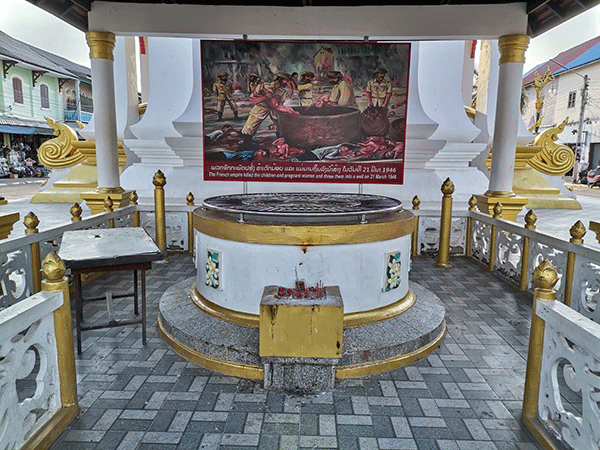 |
| A graphic painting depicts the brutalities that took place in Thakhaek on March 21, 1946. |
Commemorating the battle of Thakhaek on March 21, 1946
March 21, 1946, is a date that is remembered by everyone in Laos, because it is a day when unimaginable atrocities occurred after French forces returned to the country to launch a ferocious attack.
Hundreds of combatants and civilians, both Lao and Vietnamese, perished in the small border town of Thakhaek in central Laos, when French forces launched their biggest military operation to date in Indochina.
In a courageous attempt to repel the invading forces, soldiers and local residents fought desperately to drive them out.
The local defence force was led by Souphanouvong as its supreme commander, who led soldiers and Vietnamese and Lao civilians in a fierce, resolute and brave fight-back against the French.
In early February that year, the Party unit in Thakhaek held a meeting and issued a statement requesting that Lao and Vietnamese armed forces unify in the defence of the town, ignite the flames of resistance and build up the strength of the armed forces.
The military command and Thakhaek authorities instructed the deputy head commanders in charge of the northeast and southwest sections of the town, namely Singapo Khotchounlamany and Nguyen Cheing, to ready the 800 soldiers under their command so they would be ready to fight the enemy, no matter from which direction an attack was launched.
To strengthen the town’s defences, these two leaders instructed soldiers and civilians, including Vietnamese residents, to build forts and dig trenches in readiness for fighting in any part of the town. Under a directive to hand over their gold to bolster the resistance effort, many Lao and Vietnamese gave gold and money to supply the local militia with food, clothing, and other supplies.
But the invading French outnumbered the town’s population and were equipped with superior weaponry and quickly overwhelmed the soldiers, who realised they were facing defeat and decided to flee across the Mekong River to Thailand. The townsfolk and soldiers used small boats and even logs to carry them to safety in Nakhon Phanom province.
But the French were relentless in their attack and used planes and heavy artillery to shoot at those trying to escape, killing large numbers of soldiers and civilians and inflicting injuries on many others.
Souphanouong and some of his officials were among those attempting to escape across the river but their small motorboat was hit by enemy aircraft. A soldier and a group of Vietnamese tried to rescue the stricken occupants but they were killed. Souphanouvong was seriously injured and taken to a hospital in Nakhon Phanom province.
The French launched a savage attack on the town, brutally killing pregnant women and throwing their unborn babies into the river.
French forces also crushed people to death using huge clay mortars and pestles, shot many others and threw their bodies into the Mekong, which it is said turned red with the colour of blood. More than 3,000 people including innocent women and children were killed and many houses and other buildings were destroyed or damaged.
Souphanouvong later returned to Laos and continued to fight for liberation along with other revolutionary Lao leaders.
Ever since, March 21 has been a day of anger for the Lao people and is commemorated each year as National Disability and Sacrifice Day, to remember all national heroes and revolutionary fighters who dedicated their lives and suffered disabilities during the long years of struggle for the liberation of Laos.
Souphanouvong was trained as a civil engineer in Paris and then worked in central Vietnam and Laos from 1938 until 1945. He became a leader of the Lao Issara independence movement and served as commander-in-chief of the Lao Army of Liberation and Defence. He later served as the President of Laos from 1975 until 1991.
By Khonsavanh Latsaphao
(Latest Update March 26, 2024)
|


